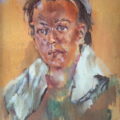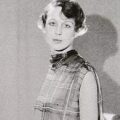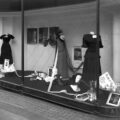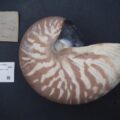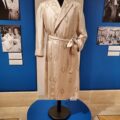Vogue 100 – A Century of Style
February 23, 2016This is the eagerly awaited exhibition which celebrates British Vogue magazine and its clutch of favourite photographers since its inception in the gloomy war-hit Britain of 1916.At The National Portrait Gallery until May 22
Normally, the women of Britain eagerly bought American Vogue for a slice of overseas glamour, but because of the war supplies were disrupted. Conde Nast thought a British version really could work, and sales of the magazine have never faltered. It was originally put out bi-weekly, and sometimes with extra editions or spin offs, which shows how popular Vogue was on its launch. After a few years it settled down into the monthly edition of Vogue UK we have today.
All fashionistas know Vogue. For me my first exposure was the gaudy 1980s pages. For many it will be the 1990s, or the 1970s. Perhaps that’s why as you enter the exhibition, you will find yourself wandering into these sections first – these brighter and more familiar images drawing fans in.
But I was keen to begin at the beginning, and after accidentally venturing back out into the gift shop for the first time in my life I think I found myself consulting the map of the exhibition, which directed me back though the galleries against the tide to the room with the earliest images in it. Having admired images from 1918 and the 1920s, I progressed though the “Vogue Archive” section, which delivered me out at the 1960s. I was slightly ruffled to have to again go back to get to the 1930s onwards. I can’t help thinking a lot of people will miss certain rooms and I think this is a real shame, since every room has been designed with a character of its own.
Conceived by theatre and opera set designer Patrick Kinmonth, the early rooms have a pastel conservatory feel, the archive room has a (very chic) basement library effect, and there is a very striking lacquer red room for the 1940s, taking its cue from a Cecil Beaton portrait in the same colour. The fonts of the wall plaques and captions, lighting, frame and hang changes too, from intimate photos in niches to crowded salon-style hangs to brightly lit, huge prints leaning against specially constructed shelves.
The Vogue Archive at Vogue 100
I loved the Vogue Archive. In a dim room to protect the original magazine copies it displayed one magazine for every year, alternating a closed volume so that you could see the cover, with an open version which allowed you to read tantalising snippets of articles. I went on a Friday afternoon and it was quite busy, making staying to read each one seem a little selfish as the tide bumped impatiently against me, but I was particularly hooked on an early article about the Chelsea Ball, a splendid dress up event that “could turn out to be an orgy” as the author breathlessly reported, as well as a completely Lee Miller article from WW2, completely opposite in tone which described conditions as Miller joined fighters in harsh conditions.
The first was complete with sparkling illustrations, the second Miller’s own photographs. I was longing to turn the page and found myself making a mental note to enquire at Vogue about visiting their real archive. I know that this is a visual exhibition celebrating the photographs but it was a shame that Vogue’s journalism in the sense of writing was barely acknowledged – a carefully chosen excerpt of an accompanying article from the decade displayed alongside the images could have really enhanced the mood of each room. It’s fascinating to see how the style of writing changes along with the decades.
Antique Prints
Robin Muir
But let’s talk about the pictures. Robin Muir, the curator, has talked about how much effort he went to to track down images for the exhibition and it has really paid off – you can see the love and care there. He wanted to include original prints, battered, marked up or pristine as they came, and all the slightly bashed edges and blue pencil give the photos weight and history. You can imagine them being pinned up and peered at in a darkroom, or slapped down on desks in a busy newsroom to be examined. Newer images have evidently be specially printed for the exhibition, and the huge, glossy c-type prints have an appeal of their own.
Most of these images are iconic and I recognised above half of them. Probably for me it was a mixture of seeing them the first time round in the magazine (I’m an avid Vogue reader), seeing then in other exhibitions, and through re-prints and researching them online for my own articles. Whichever way, it was a joy to see them again. There’s the 1920s heiress Nancy Cunard, with her bracelets stacked up to her elbows and her rings of heavy eyeliner. There’s the model in the ballgown in the bomb damaged building, there’s the bizarre photoshoot with the model and the tribesmen. There’s a billion Kate Mosses and that lovely Sarah Moon photograph in homage to Pierre Bonnard.
Vogue Photographers
Taking of the photographers themselves, Vogue has always, it seems, stuck to its favourites. Just like sometimes you feel that yes, Moss is a striking model but gosh Vogue, couldn’t you let someone else in once in a while? No, not Cara Delavigne… It’s the same with the photographers. Irving Penn, Lord Snowdon, Mario Testino, Norman Parkinson and David Bailey are good photographers but when people say they’re iconic I think it is because Vogue made them so. Now in this exhibition, Vogue smugly celebrates its own celebrities.
As for the subjects, Vogue started out photographing society beauties and theatre celebrities, but some models were hired, initially from the chorus line. It was all about the clothes from the very beginning. The very first cover trumpets “Forecast of Autumn Fashions”. But later it branched out into the arts too – by the 1960s there’s a feature on the artist Henri Matisse in his studio in full colour and doleful portraits of poet Dylan Thomas in a graveyard.
Theatre director Orson Welles, photographed by Irving Penn, sits lumpenly on a hunk of carpet. Penn also gets permission to show portraits of railway porters and ordinary men of the street. Perhaps it’s not shown but amongst all these great and interesting looking men, none of whom are beauties, I never saw an image of a woman who was great or merely interesting looking – just beautiful.
Films of Vogue photoshoots
There are hypnotic loops of short films of some of the more recent photoshoots. Cara sticks her tongue out, models look surprised, and Romeo Beckham pouts, all in living motion. In another film room you are invited to guess which of several different versions of the same setup in a photoshoot made it to the final magazine. Sometimes the results are surprising – the model looks down awkwardly, or the colour is muddy. As well as this, it’s quite noticeable how much the clear, crisp image of the original is changed in print – edges are much blurrier, the photo looks simplified, the colour is changed.
Of course, with this survey you get a glimpse of fashion though the ages. A 1910s shot of a model in diaphanous lace is rather daring, and there are structured suits, ballgowns and hot pants in the mix. Of course, designers like Christian Dior, Yves Saint Laurent and Alexander McQueen are all represented. But while Vogue has always been about fashion, it’s also about mood so how clearly you see each garment is up to the stylist and photographer. Often, as my mother complains, it’s barely at all. But then again, Vogue isn’t a clothes catalogue, it’s a vehicle for dreams and imagination.
For me, the most exciting imagery in the whole show was the rooms with the years 2000s and 2010s. The photos become huge, the lighting bright, the frames unobtrusive and the walls white, like a modern gallery. And the images themselves, well, there’s lots of Tim Walker and I’ve always been a huge fan.
His pictures are whimsical, beautiful and fairytale like yet always with a luminously clear quality. His most famous image is probably the very silly one of Alexander McQueen squeezed into one of his own creations with Isabella Blow who wears a tall hat holding his skirt while a tower burns in the background, but I don’t think this is here. Instead we have a very different Alexander McQueen, posing all in white with a cigarette and a skull.
There is also a lovely recent portrait by the same photographer of Vivienne Westwood, with a coral diadem and orange roses. And finally my favourite, Kirsi Pyrhönen in Mongolia, which shows the pink cheeked model all in (presumably) yak fur, with a yak jacket but also yak leggings and a horned yak hood riding a yak against a blue sky. She looks like a very elegant Max from Where the Wild Things Are.
The exhibition will undoubtedly be a success, despite its expensive entry fee (£19 full price with donation). The dedication of the curator and the decision to use a set designer for a memorable visual impact will be a great part of this, and the great name of Vogue does the rest.
Vogue 100: A Century of Style is at the National Portrait Gallery, London, from 11 February – 22 May 2016, sponsored by Leon Max.






